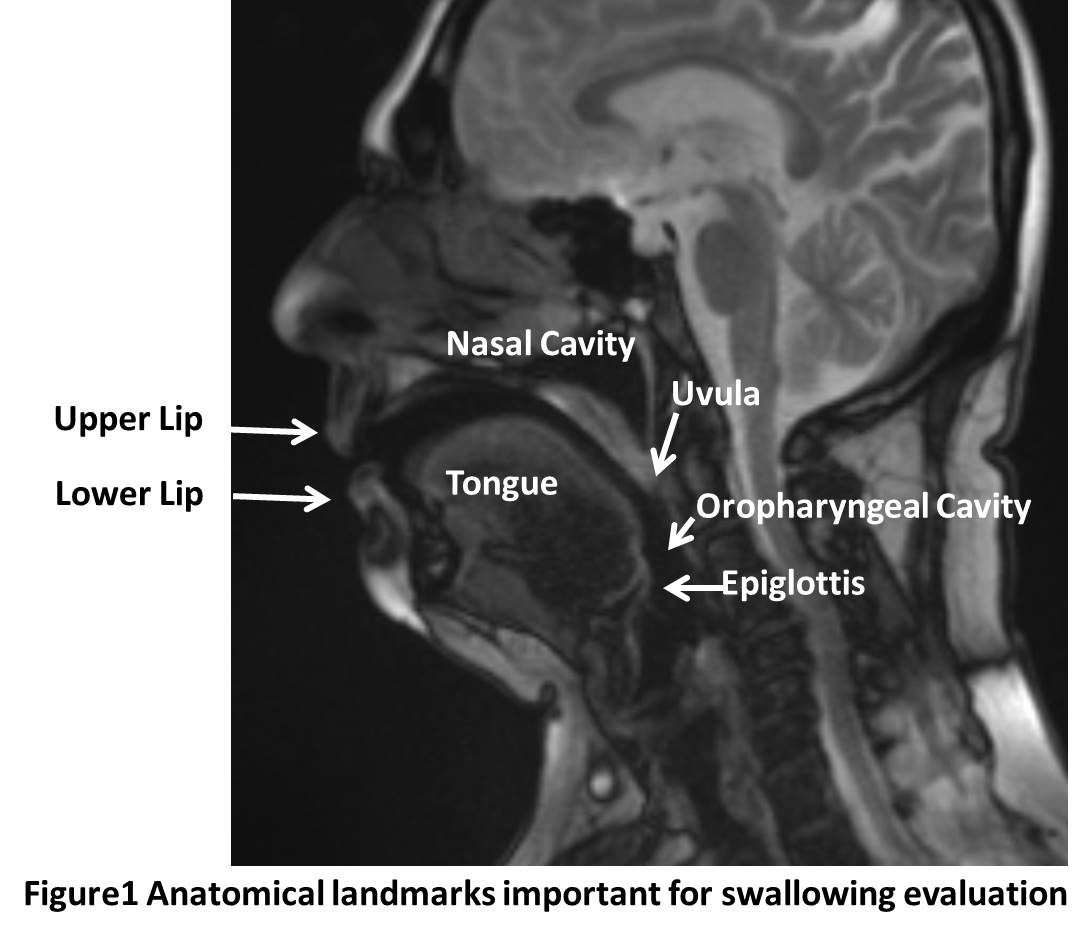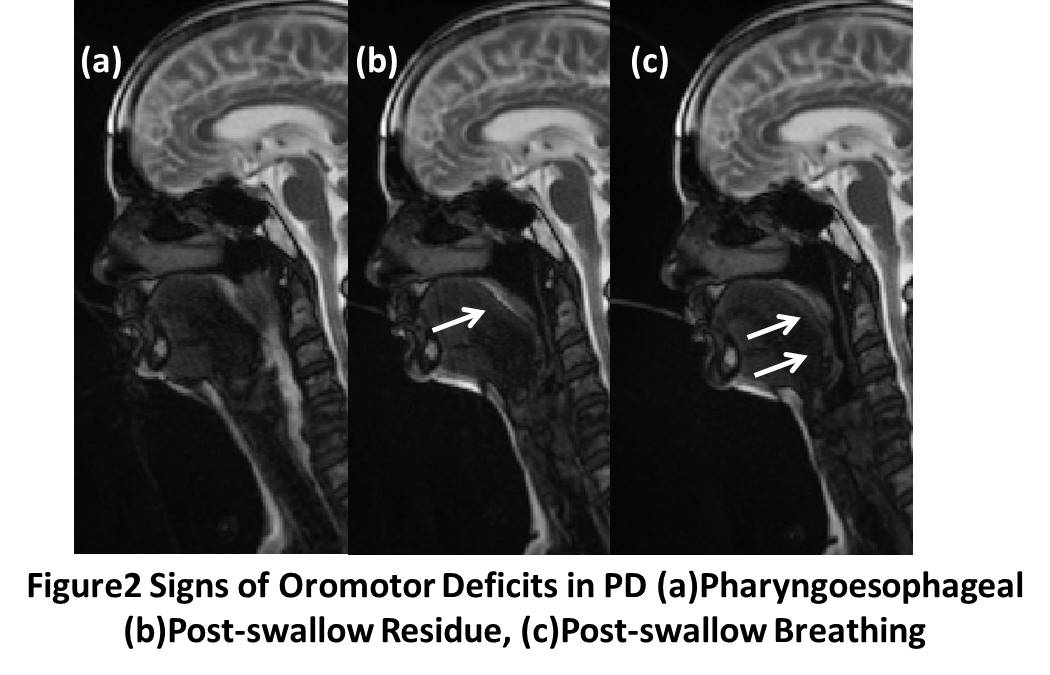Category: Other
Objective: Observing subtle oromotor signs (if any) and planning rehabilitation in early stage PD.
Background: Dysphagia is a common oromotor symptom in PD but is difficult to identify, increasing dehydration, malnutrition, and aspiration-pneumonia[1] Swallowing and coordination with breathing are often missed in early stages[1,2,3] These deficits are refractory to standard drug therapies[4] and deep brain stimulation[5] but behavioural intervention may help[2,6] Pharyngeal-phase of swallowing needs optimal intervention[7,8] With heterogeneity in PD, complexity of oromotor signs, difficult to diagnose early, planning the intervention is a challenge to prevent mortality.
Method: Participants-12subjects(6M and 6F) diagnosed with idiopathic PD and 6healthy controls(HC 3M and 3F). Clinical assessments- UPDRS, SDQ, Neurodegeneration dysphagia(CADN). MRI acquisition of dynamic images on 1.5T system (Aera, Siemens Healthcare, Germany) with T2 trueFISP (trufi-cine) sequence, [FOV230, TR162.54msec, TE1.27msec, FA44 degrees, ST10mm, 19.2fps, AT8.53min] Swallowing bolus- normal saline (NS, 0.9%) delivered in mouth (rate 2ml/sec), parameters (i)jaw movement, (ii)tongue positioning, (iii)bolus transit (iv)velar closure, (v)hyoid bone elevation, (vi)epiglotic closure, (vii)pharyngeal wave, (viii)arytenoid movement, (ix)residual bolus, (x)spooling of saliva or bolus.
Results: UPDRS oromotor functions mean scores (i)speech 1.87±0.58SD with range 0–3 (ii)Drooling 0.94, range 0–2 (iii)chewing–swallowing 0.25, range 0–1 (iv)facial Expression 0.75, range 0–2. SDQ scores negative for all the subjects (Score<11) and CADN scores were also negative (<1.5 not considered for further assessment) Dynamic MR images show in oral phase 58% of PD subjects had delayed tongue posture, 50% tongue wave, and 33.3% reverse propulsion reflex In oropharyngeal phase 25% had delayed hyoid motion, 33.3% transit time and velar closure/slow release 50%. In pharyngoesophageal phase 16.6% had modified peristaltic motion, bolus residue in 33.3% and 41.6% velar-release with epiglottic-arytenoid movement during breathing[Figure1][Figure2].
Conclusion: With dMR images, information demonstrated to patients/ care-givers and the oromotor exercises are tailored Thus customization of remediation-program on individualized subtle oromotor signs is the key to cater early intervention and prevent late stage dysphagia, aspiration-pneumonia in patients with PD.
References: [1]Wang CM, Shieh WY, Weng YH, Hsu YH, Wu YR. Non-invasive assessment determine the swallowing and respiration dysfunction in early Parkinson’s disease. Parkinsonism Relat Disord. 2017;42:22-27. doi:10.1016/j.parkreldis.2017.05.024. [2]Ciucci MR, Grant LM, Rajamanickam ES, Hilby BL, Blue KV, Jones CA, Kelm-Nelson CA. Early identification and treatment of communication and swallowing deficits in Parkinson disease. Semin Speech Lang. 2013;34(3):185-202. doi: 10.1055/s-0033-1358367 [3]Cullen KP, Grant LM, Kelm-Nelson CA, Brauer AFL, Bickelhaupt LB, Russell JA, Ciucci MR. Pink1 -/- Rats Show Early-Onset Swallowing Deficits and Correlative Brainstem Pathology. Dysphagia. 2018;33(6):749-758. doi:10.1007/s00455-018-9896-5. [4]Baijens LW, Speyer R. Effects of therapy for dysphagia in Parkinson’s disease: systematic review. Dysphagia. 2009; 24(1):91–102. [5]Narayana S, Jacks A, Robin DA, et al. A noninvasive imaging approach to understanding speech changes following deep brain stimulation in Parkinson’s disease. Am J Speech Lang Pathol. 2009;18(2):146–161. [6]Pinto S, Ozsancak C, Tripoliti E, Thobois S, Limousin-Dowsey P, Auzou P. Treatments for dysarthria in Parkinson’s disease. Lancet Neurol. 2004; 3(9):547–556. [7]Hollenstein M, Thwaites P, Bütikofer S, Heinrich H, Sauter M, Ulmer I, Pohl D, Ang D, Eberli D, Schwizer W, Fried M, Distler O, Fox M, Misselwitz B. Pharyngeal swallowing and oesophageal motility during a solid meal test: a prospective study in healthy volunteers and patients with major motility disorders. Lancet Gastroenterol Hepatol. 2017;2(9):644-653. doi:10.1016/S2468-1253(17)30151-6. [8]Jones CA, Hoffman MR, Lin L, Abdelhalim S, Jiang JJ, McCulloch TM. Identification of swallowing disorders in early and mid-stage Parkinson’s disease using pattern recognition of pharyngeal high-resolution manometry data. Neurogastroenterol Motil. 2018;30(4):e13236. doi:10.1111/nmo.13236.
To cite this abstract in AMA style:
S.G Gudwani, K.S Sharma, P.U Upadhyay, S.K Kumaran, R.S Sagar, R.D Dhamija. Customizing Rehabilitation based on oromotor function assessed with dynamic MRI in early Parkinson’s disease [abstract]. Mov Disord. 2020; 35 (suppl 1). https://www.mdsabstracts.org/abstract/customizing-rehabilitation-based-on-oromotor-function-assessed-with-dynamic-mri-in-early-parkinsons-disease/. Accessed April 26, 2025.« Back to MDS Virtual Congress 2020
MDS Abstracts - https://www.mdsabstracts.org/abstract/customizing-rehabilitation-based-on-oromotor-function-assessed-with-dynamic-mri-in-early-parkinsons-disease/


